How to make perfect smoked mackerel pâté
A delicious dinner in 10 minutes – how can anyone not love the mackerel?
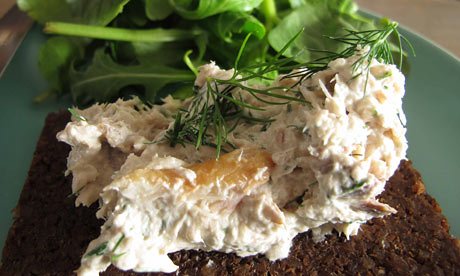
Felicity's perfect smoked mackerel pâté. Photograph: Felicity Cloake
I'm not sure that mackerel quite qualifies as underrated – certainly we all bang on enough about its oily virtues, yet I'm not sure how many of us actually eat this handsome little fish on a regular basis. The poor thing is often berated for its excessive "fishiness" (which seems a little like having a go at Hugh Fearnley-Whittingstall for being a bit too earnest), possibly because, thanks to all those lovely omega-3 oils which make it such a hit with nutritionists, the mackerel does not like to be kept waiting. Indeed, so quickly does it spoil that fishermen were given special dispensation to sell them on Sundays, even the Church recognising the value of a spanking fresh fish.
And because most of us aren't lucky enough to be able to catch our own wriggling little tiger-striped beauties on a regular basis, that makes smoked mackerel particularly valuable. Interestingly Jane Grigson describes it as "a fairly new ... delicacy, that has become popular in the last four or five years" in her book English Food, published nearly 40 years ago, but if so, it's become a modern classic (and certainly more resilient than many of its 70s contemporaries: Waitrose reported that February sales of hot smoked mackerel were up 23% on 2011. I'm not sure they even sell Smash instant mashed potato.)
Grigson recommends serving smoked mackerel with gooseberry sauce, but I think one of the most delicious ways to use this fish is in a pâté. The oiliness becomes a virtue and the resulting creamy texture tames the rich fishy flavour which some object to. Indeed, my flatmate's boyfriend, who definitely doesn't do fishy fish, was seen foraging for second helpings of this in the fridge. And if that isn't high praise ...
Hot or cold smoked fish?
Smoked mackerel pâté is always made from hot smoked mackerel – Grigson claims the cold smoked sort is "much superior in flavour and closer to smoked salmon in texture, but being more difficult to cure, it is much harder to find". To put such a delicacy in a food processor would, to my mind, be a crime: if you find it, eat it in slivers with a little pickled beetroot and crème fraîche. So the mackerel part is easy. Despite the simplicity of the recipe, however, the few other ingredients are up for debate: in particular, which dairy product to cut it with.
Choice of cheese
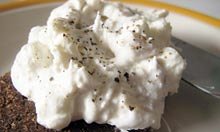
David Cameron's recipe smoked mackerel pâté. Photograph: Felicity Cloake
Fresh cheese is a popular addition – like olive magazine, my mum always uses cream cheese, while Delia gets all exotic with ricotta, and the BBC's food site and David Cameron plump for the more homely cottage cheese (so proud is the Prime Minister of this particular recipe that he has submitted it to a number of charity collections).
The kindest thing I can say about Cammers' recipe is that at least it isn't the BBC's, which "liquidises" everything to give a sloppy, distinctly grainy result that's more like a lumpy dip than a pâté: my testing team is not impressed. David's is rather curious, deploying a relatively meagre amount of fish which makes the results more like a cheese and mackerel salad than a fish pâté. Perhaps it's an austerity thing.
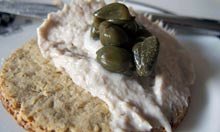
Delia recipe smoked mackerel pâté. Photograph: Felicity Cloake
Delia's recipe is more successful, although it may well have benefited from comparison with the other two, because Alex is moved to observe that "you can tell this actually came from a fish". The ricotta is smoother than David's cottage cheese, but I still prefer cream cheese – a good pâté should be a textural as well as a taste pleasure, and olive magazine's cream cheese gives things a silky finish.
Cream: a gentle let down
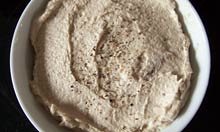
Country Life recipe smoked mackerel pâté. Photograph: Felicity Cloake
With the exception of olive's cream-cheese-only recipe, the others all loosen their cheese with something a little runnier: the BBC and Delia use sour cream, and the PM, perhaps watching his waistline, goes for Greek yoghurt. Both are wise choices: such rich ingredients are crying out for something tangy, as I discover when I taste Country Life's perfect smoked mackerel pâté, which uses cream cheese and double cream. It's so creamy it's almost bland, even with a squeeze of lemon juice.
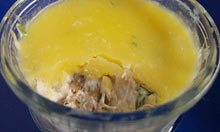
Matt Tebbutt recipe smoked mackerel pâté. Photograph: Felicity Cloake
Some recipes ditch the cheese element altogether: Matt Tebutt uses sour cream alone, and Hugh Fearnley-Whittingstall and Nick Fisher go for crème fraîche in the River Cottage Fish Book. Both, however, seem to be aiming for a more distinctively fishy result than I'm used to: indeed, the River Cottage chaps use just 1 tablespoon of crème fraîche to 2 smoked mackerel fillets, and Matt serves his pâté in ramekins topped with butter, making it more akin to potted fish than anything spreadable. I prefer a little more creaminess, but I do like the lighter, more subtle tang of Hugh's crème fraîche – I think it will work brilliantly to loosen the smooth cream cheese.
Method: how much of a pasting?
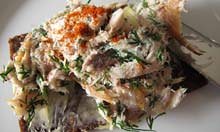
River Cottage recipe smoked mackerel pâté. Photograph: Felicity Cloake
I usually reach for the food processor to make smoked mackerel pâté – it's essential for a really creamy result, and I find mashing the ingredients together with a fork, as Matt Tebbutt and David Cameron suggest, gives too coarse a finish. However, the River Cottage recipe purées half the fish, and then flakes in the rest – still too heavy for my liking, but a few pieces of fish look attractive, and give the pâté a more interesting, less fish-paste like texture.
Other ingredients
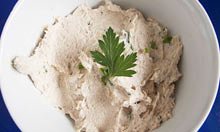
olive magazine recipe smoked mackerel pâté. Photograph: Felicity Cloake
Like so many creamy recipes, smoked mackerel pâté benefits from a little heat. David Cameron uses Tabasco, which isn't bad, but, like Delia's cayenne pepper, it doesn't really add much but spice. olive adds some creamed horseradish which works much better, but having recently discovered the fierier pleasures of the fresh stuff, I'm going to side with Hugh and Nick, and use that instead – it gives a cleaner heat to the pâté.
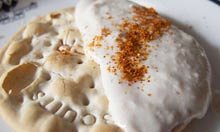
BBC Good Food recipe smoked mackerel pâté. Photograph: Felicity Cloake
Their use of sugar puzzles me though – the pâté really doesn't need it, but not as much as Delia and the BBC's grating of nutmeg. I adore the stuff, but it has no place here.
Herb-wise, olive add chives and parsley, River Cottage suggests chives or dill, and Matt Tebbutt uses dill – frankly the pâté is pretty tasty without herbs, but the aniseedy dill marries so well with the oily fish and the sweet heat of the horseradish that it would be a shame to leave it out, especially as it looks so pretty.
Perfect smoked mackerel pâté

Perfect smoked mackerel pâté. Photograph: Felicity Cloake
This is wonderful served on sour rye bread, or crisp toast, with some pickled capers or beetroot, and a peppery watercress salad. Dinner in 10 minutes – how can anyone not love the mackerel?
Serves 4
- 3 hot smoked mackerel fillets
- 150g cream cheese
- 100g crème fraîche
- 3 tsp freshly grated horseradish
- Lemon, to squeeze
- Small handful of dill, finely chopped
1. Skin the mackerel fillets and do a quick check for any bones – they're not unknown. Flake three quarters into a food processor with the cheese, crème fraîche and horseradish and whizz until smooth.
2. Add a good grinding of black pepper, and lemon juice to taste, then fold through the dill and the remaining fish. Serve with rye bread or crisp toast.
How else do you like to showcase mackerel, the dandy of the seas; or are you firmly in the "too fishy" camp? And, if so, how does one make oily fish more attractive to the doubters?